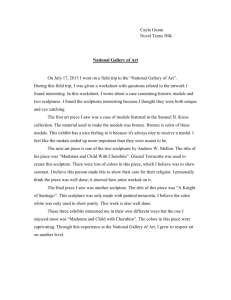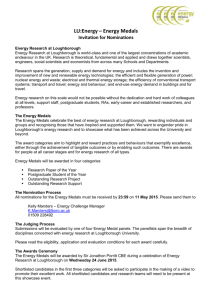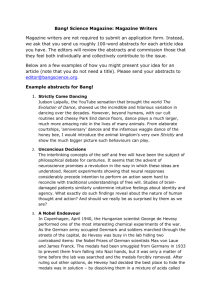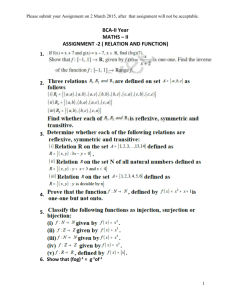1920-1929 * The Olympic Games of the 1920s
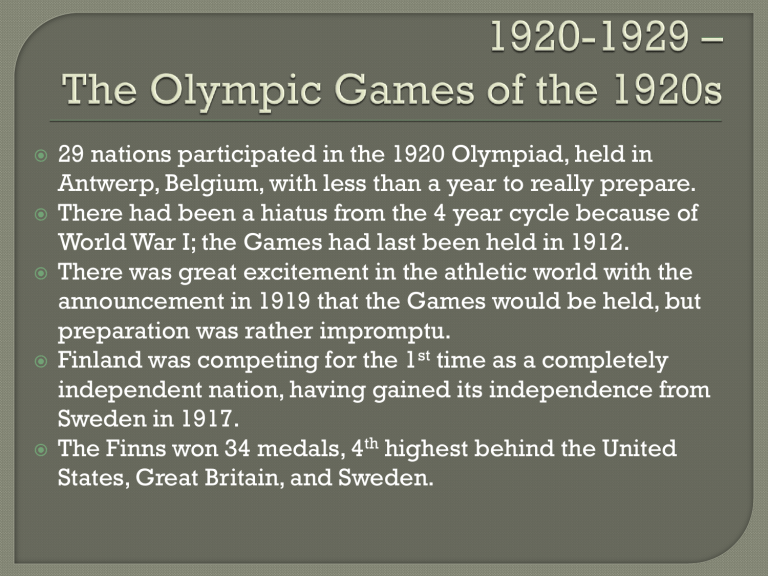
29 nations participated in the 1920 Olympiad, held in
Antwerp, Belgium, with less than a year to really prepare.
There had been a hiatus from the 4 year cycle because of
World War I; the Games had last been held in 1912.
There was great excitement in the athletic world with the announcement in 1919 that the Games would be held, but preparation was rather impromptu.
Finland was competing for the 1 st time as a completely independent nation, having gained its independence from
Sweden in 1917.
The Finns won 34 medals, 4 th highest behind the United
States, Great Britain, and Sweden.
Paavo Nurmi of Finland won the 10K race and the 10K cross-country race (no longer held).
A. G. Hill of Great Britain also won 2 gold medals in middle-distance races (800 and 1500 meters).
Charlie Paddock of the United States won the 100-meter race, giving him the title of world's fastest man, with
American winners in 7 other track and field events.
Duke Kahanamoku of Hawaii and Norman Ross of
Chicago won gold in swimming (Ross with 3,
Kahanamoku 2).
American women swept the swim sprints, led by Etheda
Bleibtrey,
The Americans were strong in shooting events, winning
8 gold’s there and numerous other medals.
Olympic athletes were true amateurs and any of them who made any money on being an Olympic athlete lost his or her amateur standing and was considered a professional.
This made them ineligible to compete in further amateur events, which, of course, included the
Olympics.
This was true of athletes in all sports and nations, so most of these athletes were happy to find jobs that allowed them some flexibility to train for their events.
Unlike today, athletes train every day, all year round, most of these athletes just trained “in season” each year.
In 1924 there were 2 Olympic Games, the
Summer Games of Paris and, for the 1 st time,
Winter Games, held in Chamonix, France.
The Winter Games were almost exclusively
European nations and the United States and
Canada, among the 16 competing countries.
At the Winter Games, the United States won a total of 4 medals and finished 5 th in medal competition, which was dominated by Norway and Finland.
There were only 16 events. There was little interest in the Games in the United States.
The Summer Games in Paris, by contrast, had 126 events, 44 countries competing, and over 3,000 athletes.
The U.S. team dominated in the games with
Finland, France, and Great Britain next highest in medals, but far behind the U.S. total of 45 gold medals and 99 total medals.
The increased number of nations, the longer time for planning, and the increased attention by the American media made some Olympic winners American and/or world heroes.
As a team, the U.S. men took 1 st and 2 nd in the broad (now long) jump, the high jump, the shot put, the hammer throw, the 200 meter, and the decathlon.
Johnny Weissmuller of Chicago took gold medals in both the
100- and 400-meter freestyle swimming events.
In the 100, the United States had a sweep with Duke
Kahanamoku 2 nd and Sam Kahanamoku 3 rd .
The United States took 13 gold medals in men's and women's swimming and diving.
Helen Wills and Vince Richards of the United States took gold medals in singles tennis as well as combining with others to win the men's and women's doubles titles.
The final Olympic Games of the decade were held in 1928.
The Winter Olympics were in St. Moritz,
Switzerland, and again American impact at the
Games and interest at home were minimal.
25 nations and 464 athletes competed, a marked increase from Chamonix 4 years earlier, but there were only 14 events.
The United States took gold medals in 1 and 4man bobsleds and totaled 6 medals (4 in bobsleds) to finish 2 nd in medal totals to
Norway's 15.
The 1928 Games in Amsterdam were much better covered and there was increased interest in the United States and worldwide.
There had been strong consideration of awarding the Games to Los Angeles, but finally, that city was awarded the 1932
Games.
Countries from South America (Argentina, Chile, Uruguay),
Africa (Egypt, South Africa), Asia (Japan, Philippines, India), and Australia/New Zealand competed and won medals.
The U.S. victories now were seen as truer world victories, rather than just European and North American triumphs.
The United States triumphed in the Amsterdam Games with
22 gold medals and 56 total medals.
Germany, now dramatically recovered from the devastation of the world war, had 31 medals, including 10 gold.
Repeat winners included, most notably Paavo
Nurmi, who took another gold and a silver medal to end his fabulous Olympic career.
Nurmi toured Europe and the US, and was deemed a professional for taking too much money for his expenses in Germany.
He and the Finns appealed, but he was denied and was unable to compete in the 1932 Games.
He finished his Olympic career with 9 gold and 3 silver medals in 12 events.
Another repeat winner was Johnny Weissmuller, who once again won the 100-meter freestyle.
The continued American success at the Olympic
Games and the anticipation of hosting the 1932
Games created greater interest in the Olympic
Games in the US.
Gertrude Ederle, winner of 2 bronze medals for the 100- and 400-meter freestyles and a gold medal as part of a victorious U.S. relay team at the 1924 Paris Games, swam from France to
England in 14 hours, 30 minutes, a record for men or women.
Ederle, a native of New York City, was welcomed home with a tickertape parade on Broadway in
New York.
